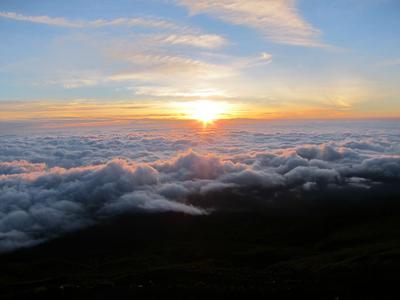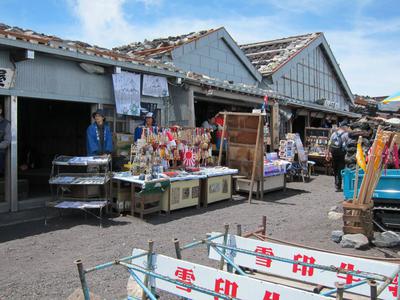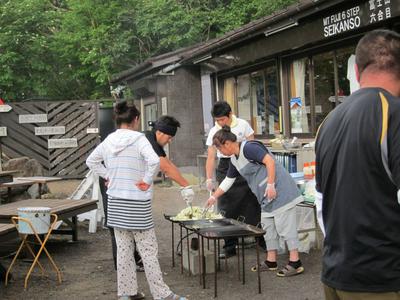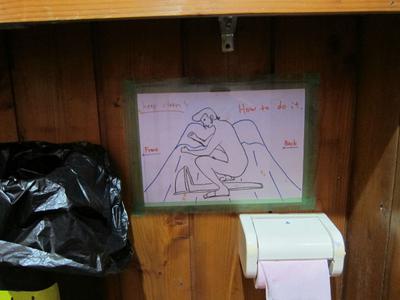My 2012 climb on the Kawaguchiko and Gotemba Routes
by Jenny
(Alaska)

Sunrise from the Mt. Fuji slopes

Mt. Fuji summit shops

Supper @ the Mt. Fuji 6th Station Seikanso mountain hut

Mt. Fuji mountain hut toilet cartoon instructions
Using the information from this site, and following the advice of many kind people, I made it to the summit of Fuji-san in mid-July 2012. I'm not an athlete, but I did a lot of hill-climbing to prepare for the trip.
To possibly avoid altitude sickness, I took the bus from Tokyo (It's across the street from the Shinjuku Station west exit and you can make reservations online) to the Kawaguchiko 5th station, but didn't start out climbing right away. Instead, I enjoyed the day and continued my 3 days of carbo-loading with noodles and Japanese bread.
I also, at my doctor's recommendation, started taking ibuprofen the day before the climb, to head off some knee problems and possible headaches from the thin air.
A word of warning to anyone going to the 5th station or planning to climb. No free toilets anywhere, so bring a bag of 100 yen coins.
Also, there are almost no trash cans, so be prepared to carry all your trash with you. Bring at least two trash bags. Use one to line your backpack to keep your gear dry and grit-free. Use the others to carry your trash or to sit on if you need a dry place to sit or to bundle up your boots and other wet/gritty gear at the end of the climb.
Don't count on getting a lot of climbing info at the 5th. Do your research ahead of time.
There is some climbing gear available at the Kawaguchiko 5th, and you can purchase oxygen canisters about the size of a whipped cream can. The cap turns into a mini-mask. I bought one, just in case (didn't use it), and made sure that I had several liters of water before I started walking. Water is sold at the huts, but the price goes up as you climb. If you buy a meal, you can rest in the huts. Otherwise, you are expected to sit outside and then move on when the larger guided groups arrive and need the seating.
I also packed band-aids, self-adhesive molefoam (for possible blisters), Pepto-Bismol (anti-diarrhea), ibuprofen, camera, raincoat, rain pants, gaiters that covered my boots, warm coat, scarf, bandanna, cotton gloves and some rubber gloves to wear over them if it rains, a rain cover for my backpack, Gatorade (drank before I started climbing), Gu (a packet of pudding-like energy gel), trekking poles (the rubber tips seem to work best), a fanny pack to wear in the front to keep camera and other items handy), sunglasses, a flashlight, a headlamp, tissues (some public toilets don't supply paper), sunscreen, iPod, hand/body wipes, extra socks, a sun hat, some clean clothes, lip balm, and wore a short sleeved shirt, a long sleeved shirt and long pants (all three of synthetic material, not cotton).
I headed out on the trail in the late afternoon. The first part of the trail is flat and then it angles uphill. I stayed on the horizontal track and intersected the trail that comes up from the base of the mountain. I then climbed a short distance to the Seikanso Hut (a great guy at the Fujiyoshida City international affairs desk helped me make the reservation). My rationale was that I wanted to get a good sleep and also spend more time at elevation to help my body adjust to the altitude.
I had brought an eye mask, face mask and ear plugs because I'd heard how crowded the huts can be. Because my hut was out of the way and Japanese schools were still in session, I was the only woman in the hut and had a great night's sleep without having to use them. The hut staff cooked a great meal outdoors and left me a sack breakfast/lunch for my 2:30 a.m. departure. The weather was clear, so I wore the hiking boots, pants and a fleece jacket over both the long and short sleeved shirts. Also I wore the gloves and I wore the scarf as a head rag. (A Buff would have worked, too.) Later in the day, I changed to a cotton tenugui towel as a head scarf. (Most people wear a hat with a bill, but I don't like the way they obscure my vision.)
I was lucky it was a clear night and could see the lights of the towns at the base of the mountain. Donning my headlamp, I set out walking under a starry sky. I watched the sun rise from partway up the mountain. One advantage of being below the summit was that the trees downslope from me came alive with birdsong as the sun rose. (Fuji-san has butterflies, too.) Also, I had the mountain almost all to myself. I shared the sunrise with only 3 other people.
I then continued on up the mountain, making sure to drink frequently and to refuel with the Gu about every 30 minutes. I had been told that if you eat frequently you don't run out of energy and it worked for me. I never got tired. Also, elevation can curb the appetite and I found that to be true for me. At the higher elevations I had little interest in solid food, even the traditional GORP, chocolate, etc. The vanilla Gu was lightweight and palatable.
As the day went on, the mountain became more crowded, including large guided groups. People frequently greeted one another on the mountain, sharing a bond. Very few people climb alone, so I stood out. People were very nice when I asked them to take my photo with my camera.
With elevation, the air got thinner and everyone rested more, as often as every 20 steps or so. I noticed that people who hadn't been drinking enough water were suffering from cramps.
The trekking poles were very useful and the gloves helped a lot for using the hand-holds on the steep scrambles.
I was lucky to avoid wind and rain. At times, the mountain is very cold and the wind blows upslope, so it's important to have a full rain suit. Obviously, it's colder at night, so if you choose to do a night climb so you can watch the sunrise from the summit, bring warm clothes-hat, neck-warmer, gloves, long pants, coat, rain suit, etc.
I took my time and achieved the summit about 9 hours after I started out. I'm sure a younger person (I'm past 50) could have gone faster, but I was savoring the experience and wanted to enjoy the entire climb, not just the summit. I also stopped to help someone for about 40 minutes. Remember that you also have to descend, so don't burn yourself out on the ascent.
At the summit, it only takes an hour or so to buy the souvenirs, walk around the crater, etc. but the air was breathable and the weather was good, so I spent a lot of time on top. I underestimated the intensity of the sun, as the temperature was warm but not hot. I should have followed the example of some of the older Japanese ladies who were in the guided tours and covered more of myself. I ended up with a very bad sunburn on my arms and the back of my neck.
I have knee issues going downhill and had read several places that the Gotemba route is easier on the knees, due to the sandy trails. So, that's how I descended. The plan was to take the bus from Gotemba 5th station to the Gotemba train station and then return to where I was staying outside of Tokyo.
It was a mistake. The Gotemba route is longer than the Kawaguchiko route, and even longer than the guidebooks say because the bottom of the trail has been moved. There are almost no huts and I saw maybe 5 other people on my way down. The sand trail is not really sand and not steep enough to give you the sliding ride that is so fun when descending a snow slope. It turned out to be much harder on the knees. When I got to the bottom, almost nothing was open. That particular route doesn't have the amenities or transportation that the more popular routes do. The descent couldn't dampen my joy of being on the summit of the highest mountain in Japan, but I wouldn't recommend the route. Next time, I'll descend on the same trail I ascended.
On a side note, a fog rolled in right after I got to the end of the trail. You could hardly see four feet in front of you. Had that occurred while I was on the mountain, keeping to the trail could have been very interesting.
At the base, I used the wipes to get the grit off and changed to a clean shirt. Taping my knees with Kinesio tape (that bright-colored stuff you saw in the London Olympics) made it possible for me to walk pain-free.
This web site helped me a lot in planning my climb. Thank you!!!